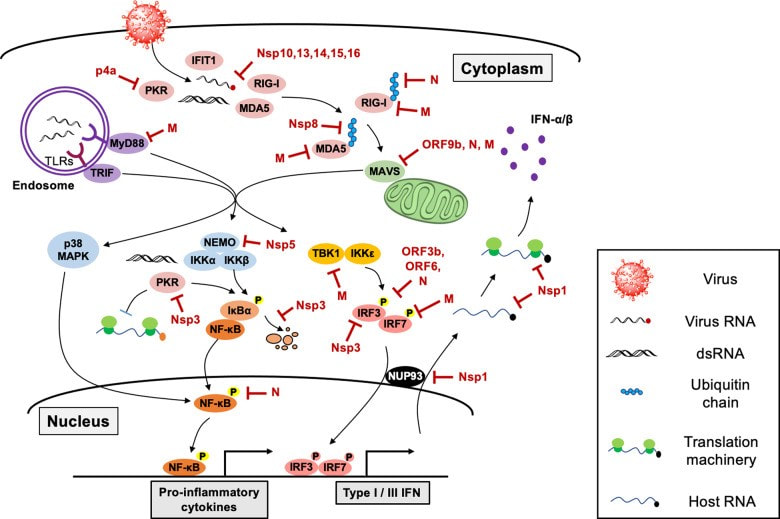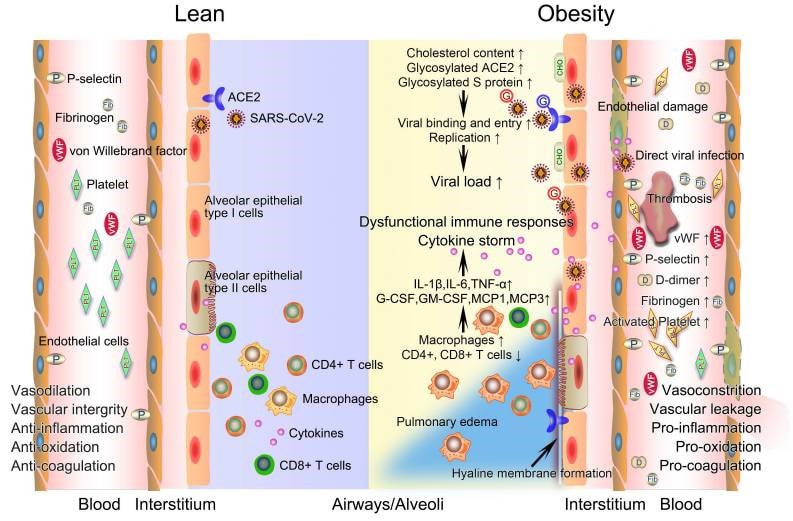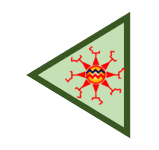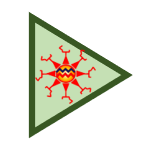COVID-19
II. Deceptive virus
Symptoms from the common cold give are due to the immune system, not the coronavirus causing the infection.[Proud]
Virus infection
Viruses infect cells by their receptor, in case of coronaviruses this is the Spike protein (S). SARS-2 Spike protein infects primarily cells with ACE-2.[Cowley] The virus immune pathology of coronaviruses have been known for decades: coronaviruses have a complicated relation with the immune system. [Perlman, Wong, Lee] In that light it might be less surprising that the weak in our society e.g., immunocompromised, elderly people and males, are more vulnerable.
Immune dysregulation
In brief, virus infections alarm the immune system by interferon responses but SARS-2 inhibits these.[JJ] Normally a wide arrange of immune factors collaborate against a virus infection,[JJ] and the precise tuning of immune responses determines their efficacy.[JJ] Virus interference leads to a dampened, altered and less effective immune initiation. The virus infection is not halted by the ineffective immune response and this response is amplified causing an immune overactivation of mostly innate immune cells and less specialized antigen-specific immunity. Such a response is associated with multi-organ syndrome, thrombosis and severe disease. [Schultze, Jacobs20]
The virus uses more tricks to disturb the immune response, one of these is the superantigen. Superantigens boosts immune responses specifically and are a major cause of severe and recurrent disease by bacteria and viruses.[Jacobs21] In severe disease innate immunity, antibodies and T-cells may be involved. [Toor, Davis]
The virus uses more tricks to disturb the immune response, one of these is the superantigen. Superantigens boosts immune responses specifically and are a major cause of severe and recurrent disease by bacteria and viruses.[Jacobs21] In severe disease innate immunity, antibodies and T-cells may be involved. [Toor, Davis]
Arms race
The immune system uses rocket science to eliminate virus, but coronaviruses use stealth technology to avoid neutralization by the immune system.[JJ]
SARS-2 has a major impact on the host immune system. It produces 16 non-structural proteins, that have interactions with 300 host proteins. At least 10 SARS-2 proteins inhibit interferon responses, the default antiviral strategy, and this pattern differs from other coronaviruses (Figure 1).[Belizário, Suryawansh, Kasuga] Vitamin D has a role in an alternative immune activation route.[Peng] By interfering with the normal antiviral immune response, SARS-2 strongly deregulates the immune system. [Oshiumi, Carty]
Administration of interferon might have a positive effect in early stage of disease but negative in severe disease,[Sodeifian] since interferons also upregulate ACE2, the receptor for SARS-2.[Busnadiego]
SARS-2 has a major impact on the host immune system. It produces 16 non-structural proteins, that have interactions with 300 host proteins. At least 10 SARS-2 proteins inhibit interferon responses, the default antiviral strategy, and this pattern differs from other coronaviruses (Figure 1).[Belizário, Suryawansh, Kasuga] Vitamin D has a role in an alternative immune activation route.[Peng] By interfering with the normal antiviral immune response, SARS-2 strongly deregulates the immune system. [Oshiumi, Carty]
Administration of interferon might have a positive effect in early stage of disease but negative in severe disease,[Sodeifian] since interferons also upregulate ACE2, the receptor for SARS-2.[Busnadiego]
Superantigen
SARS-2 has a superantigen in the Spike protein.[NG, Huang, Giamarellos-Bourboulis, Jacobs21] Superantigens derive their name from their ability to induce extreme strong immune responses, many bacteria have superantigens. Superantigens recognize antigen-specific receptors on T-cells (TCR) or B-cells (antibodies) from the outside and not from the antigen-biding domain. Therefore, superantigens can activate a large proportion of these lymphocytes, more than any normal antigen would.
Superantigens are the main cause of sepsis, which somewhat resembles the clinical picture of severe COVID-19. Such an immune response is in potential deadly, if not down-regulated. The strength of superantigen is related in the concomitant activation of multiple T-cell clones, irrespective of their antigen specificity. At first glance, it might appear counterintuitive that a pathogen provokes extreme strong immune responses.
But although superantigens produce strong immune responses, they do not mature to a high degree of specificity and these responses wane rapidly. Firstly due to tolerogenic immune responses that counteract the otherwise lethal, self-destructive immune responses. Secondly because the vast number of memory B- and T- lymphocytes are not maintained by cytokine support. Thus superantigen provoke a dangerously strong but temporary immune response against disease.
Superantigens are the main cause of sepsis, which somewhat resembles the clinical picture of severe COVID-19. Such an immune response is in potential deadly, if not down-regulated. The strength of superantigen is related in the concomitant activation of multiple T-cell clones, irrespective of their antigen specificity. At first glance, it might appear counterintuitive that a pathogen provokes extreme strong immune responses.
But although superantigens produce strong immune responses, they do not mature to a high degree of specificity and these responses wane rapidly. Firstly due to tolerogenic immune responses that counteract the otherwise lethal, self-destructive immune responses. Secondly because the vast number of memory B- and T- lymphocytes are not maintained by cytokine support. Thus superantigen provoke a dangerously strong but temporary immune response against disease.
Metabolic diseases
Vitamin D deficiency is strongly associated with diseases-related mortality.[Kumar] Normalizing vitamin D levels seems to be one of the easiest interventions to protects from severe COVID. [Heine] Also, other metabolic dysregulations, like obesity, hypertension, dyslipidemia, hyperglycemia, or diabetes, can have major impact on the severity of COVID-19 (Figure 2).[Yan] Various metabolites influence the strength and direction of immune responses.[Wege] Similar effects can be noticed from air pollution, nitrogen dioxide (NO2 ), ozone (O3 ), and particulate matter (PM).[Woodby] So it seems likely that air pollution could also be an important risk factor for sever COVID-19, especially in the lower social-economic groups.
Figure 2. The influence of obesity and other metabolic disorders on disease progression. [Yan]
Complicated immune effects
Some patients with immune deficiencies are protected from severe COVID-19 while others are more vulnerable.[Bucciol] The immunological regulation is very delicate, and minor disturbances, low-grade chronic inflammation, could greatly influence the outcome after SARS-2 infection.[Suárez-Reyes]
When the immune response is ineffective, disease progression is counteracted with a stronger immune response i.e., hyperinflammatory syndrome, which leads to severe disease.[Gustine] Vitamin D might be also needed to resolve hyperinflammatory responses. [Hu, Chiu]
When the immune response is ineffective, disease progression is counteracted with a stronger immune response i.e., hyperinflammatory syndrome, which leads to severe disease.[Gustine] Vitamin D might be also needed to resolve hyperinflammatory responses. [Hu, Chiu]





